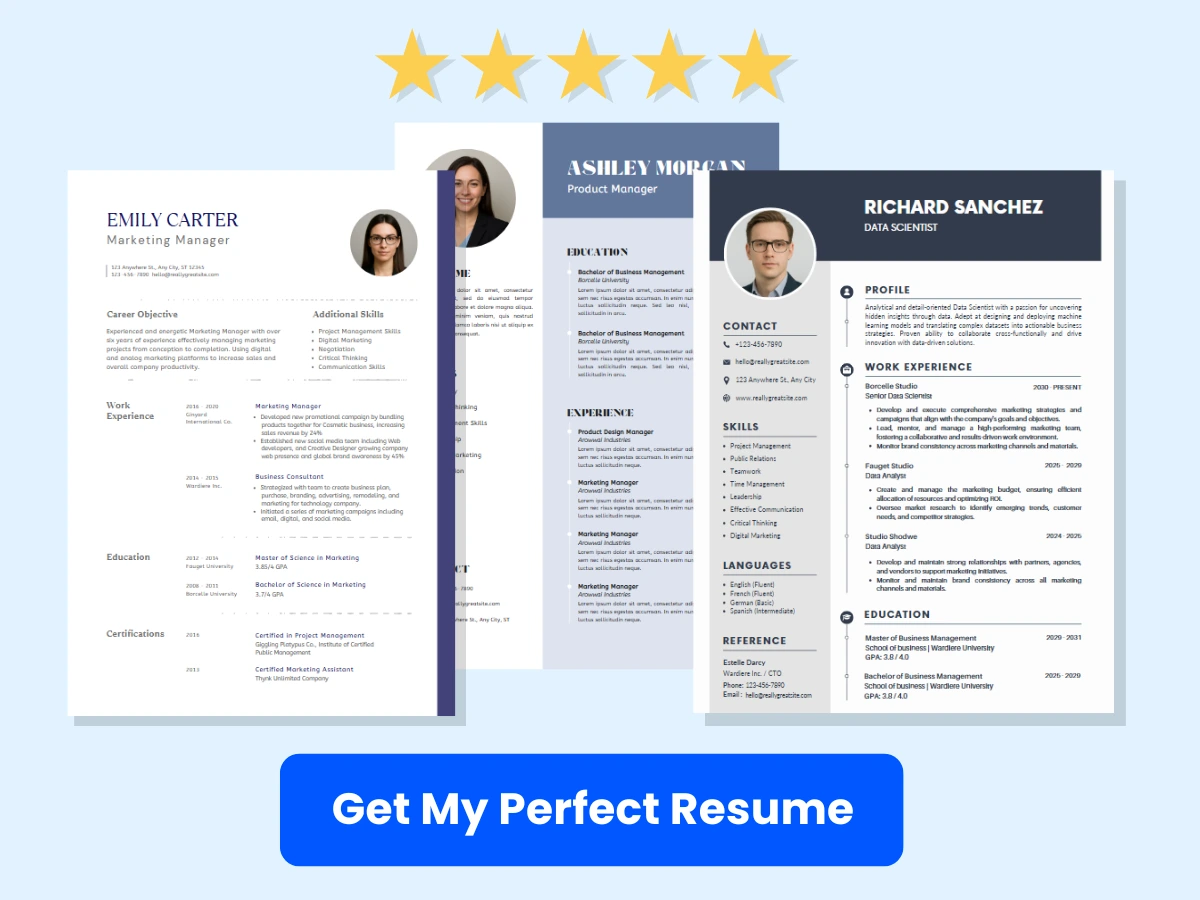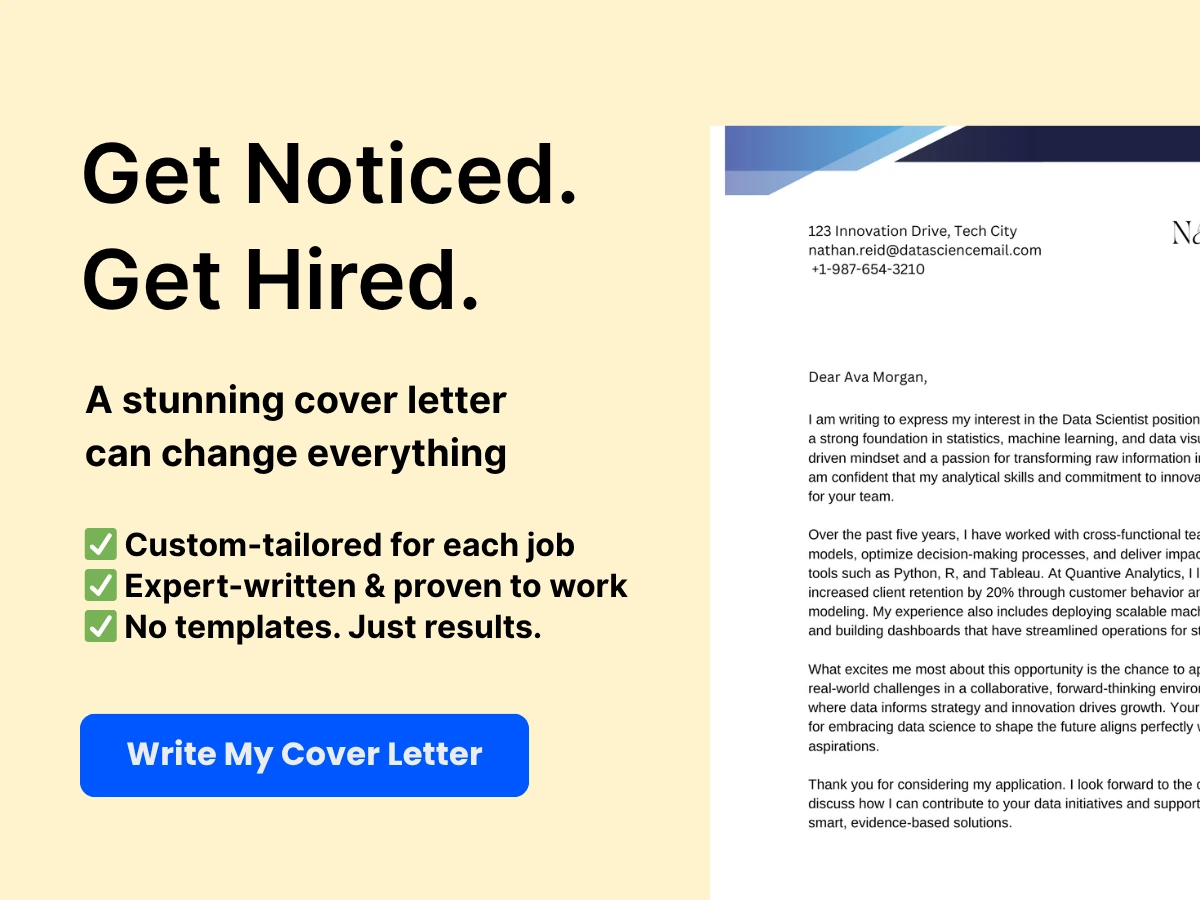When you withdraw a job application, it means you have decided to remove yourself from consideration for a particular role. This can happen at any stage of the hiring process—from submitting your resume to attending interviews.
Properly withdrawing your job application is a matter of professional courtesy. It signals to the hiring manager that you’re no longer pursuing the role, allowing them to redirect their efforts toward active candidates. It also reflects positively on your communication and integrity.
In addition to protecting your reputation, withdrawing your application in a timely and professional manner maintains goodwill with employers, which may benefit you in future job searches. If you’re planning to reapply later, it’s especially important to leave a positive impression. Having a strong cover letter and professional resume ready can also help you reenter the process with impact.
This guide provides practical tips and sample letters to help you withdraw from the hiring process with grace. You’ll also learn how to reapply tactfully if your circumstances change down the line.
By the end, you’ll know how to handle a withdrawal the right way—and how to strengthen your next job search with tools like ATS-optimized application materials and strategic planning support.


Reasons for Withdrawing a Job Application
There are many valid reasons to withdraw a job application. Doing so professionally is a sign of respect for your time and the employer’s. Below are common scenarios where a withdrawal might be necessary.
Personal Reasons
Unexpected life events—such as a health issue, family emergency, or relocation—may impact your ability to take on a new role. In such cases, withdrawing your application early helps both you and the employer avoid unnecessary steps in the hiring process.
Changes in Job Requirements or Qualifications
Sometimes, a job posting changes after you’ve applied, or you might learn new details during the interview process that make the role a poor fit. If the revised qualifications or responsibilities no longer align with your experience, it’s appropriate to step back from the opportunity.
Company Reputation or Ethics
As you research a company, you may uncover red flags regarding its ethics, leadership, or workplace culture. If the organization’s values conflict with your own, it’s better to withdraw than to risk future dissatisfaction or conflict.
Lack of Interest or Other Job Offers
You may lose interest in the role or accept another offer with a better fit. Withdrawing your application helps maintain professionalism and shows appreciation for the employer’s time. A thoughtful withdrawal can also keep the door open for future roles, especially if your LinkedIn profile and personal brand are strong and up to date.
Company Culture or Fit
Company culture is often a deciding factor in job satisfaction. If you sense a misalignment between your values and the organization’s work environment, withdrawing your application can save both parties time and help you refocus your search on roles that better suit your goals.


Withdrawing a job application doesn’t have to be difficult. Just be clear, respectful, and timely. Whether your reason is personal, professional, or preference-based, taking this step thoughtfully contributes to a polished job search strategy.
Types of Job Application Withdrawal Letters
There are several appropriate formats for withdrawing your application. Each may be more suitable depending on how far you’ve progressed in the hiring process or the nature of your communication with the employer.
Formal Letter
A formal letter is a classic and professional approach. It’s especially suitable if you’ve already participated in interviews or direct conversations with hiring personnel. Include a clear withdrawal statement, a brief reason (if desired), and a note of appreciation.
Sample formal letter format:
[Your Name] [Your Address] [City, State ZIP Code] [Date]

Employer’s Name [Employer’s Address] [City, State ZIP Code]
Dear Employer’s Name,
I am writing to inform you that I have decided to withdraw my application for the [Position Title] at [Company]. I appreciate the opportunity to apply for this position and have enjoyed learning more about your company throughout the process.
Thank you for your time and consideration. Please let me know if you need any other information from me.
Sincerely,
[Your Name]
Email Letter
An email letter may be the most convenient method to withdraw your job application. This method works well if you have not had any in-person or phone contact with the employer and have communicated primarily through email. Your email should be brief, but still professional, explaining your request and expressing your gratitude for the opportunity.


Sample email letter format:
Subject: Application Withdrawal – [Your Name]
Dear Employer’s Name,
I am writing to inform you that I have decided to withdraw my application for the [Position Title] at [Company]. I appreciate the opportunity to apply for this position and have enjoyed learning more about your company throughout the process.
Thank you for your time and consideration. Please let me know if you need any other information from me.
Sincerely,

[Your Name]
Phone Call
If you are unable to write a formal letter or email, or if you feel a phone call is more appropriate, you can contact the employer directly to withdraw your application. This method shows respect and professionalism, despite the need for a quick conversation. If you choose this method, be prepared to provide a brief explanation for your decision.
Sample phone call script:
[Your Name]: Hello, may I speak with Employer’s Name?
[Your Name]: Hello, this is [Your Name] and I am calling in regards to my job application for the [Position Title] at [Company]. I have decided to withdraw my application but wanted to thank you for the opportunity and let you know how much I appreciate your consideration.
Tips for Withdrawing a Job Application
When it comes to withdrawing a job application, there are a few things to keep in mind. Here are some tips that you can follow:


Timing of the withdrawal
It’s important to withdraw your application as soon as you’ve made the decision to do so. This is because companies often have tight timelines when it comes to filling positions, and leaving them in the dark can hold up the process. Additionally, withdrawing your application in a timely manner shows respect for the company and its time.
Avoiding negative language or criticism
When withdrawing your application, it’s crucial to avoid negative language or criticism. While you may have your reasons for wanting to withdraw your application, being negative or critical can burn bridges and harm your reputation. Instead, focus on keeping your tone positive and neutral.
Maintaining positive relationships with the company and its employees
Withdrawing your application doesn’t mean burning bridges with the company or its employees. It’s important to maintain positive relationships, as you never know when you might cross paths again in the future. You can do this by thanking the company and its employees for their time and consideration, and expressing your interest in potentially working with them in the future.
Being honest and direct
While it’s important to maintain positive relationships, it’s equally important to be honest and direct about your decision to withdraw your application. You don’t have to go into great detail about why you’re withdrawing, but it helps to provide a brief explanation. This shows that you value the company and its time, and that you’re not simply withdrawing because of a lack of interest.
Withdrawing a job application can be daunting, but following these tips can help you do it with professionalism and grace. Remember to withdraw your application in a timely manner, avoid negative language or criticism, maintain positive relationships, and be honest and direct.


Writing a Formal Letter to Withdraw a Job Application
When you have decided to withdraw a job application, it is important to do so in a professional and cordial manner. One way to accomplish this is by writing a formal letter to the employer or recruiter.
Format of the Letter
The format of a formal letter to withdraw a job application should follow the standard structure of a business letter:
- Sender’s address
- Date
- Recipient’s address
- Salutation
- Body of the letter
- Closing
- Signature
Details to Include in the Letter
In the body of the letter, you should include the following details:
- Your name and contact information
- The job position that you applied for
- The date that you submitted your application
- The reason for withdrawing your application (optional)
- Thank the employer/recruiter for their time and consideration
- Request confirmation of the withdrawal of your application (optional)
Sample Formal Letter
Here is an example of a formal letter to withdraw a job application:
[Your Name] [Your Address] [City, State ZIP Code] [Your Email] [Today’s Date]
[Employer/Recruiter Name] [Company Name] [Address] [City, State ZIP Code]
Dear [Salutation],
I am writing this letter to formally withdraw my application for the position of [Job Title] that I submitted to your company on [Date of Application]. After careful consideration, I have decided that this role is not the right fit for me at this time.
I would like to express my sincere appreciation for the opportunity to apply for this position and for the time and consideration you have given my application. I have a great deal of respect for your organization and appreciate the work that you do.
Please confirm that my application has been withdrawn from consideration for this position. If there is any additional information that I can provide to assist you in this process, please do not hesitate to contact me.
Thank you again for your time, and I wish you and your company continued success.
Sincerely,
[Your Signature] [Your Name]
Writing a formal letter to withdraw a job application requires a structured format and clear communication of necessary details. Be sincere and respectful in your communication, as it reflects positively on you as a professional.
Writing an Email to Withdraw a Job Application
When withdrawing a job application, it’s important to do so in a professional and courteous manner. Email is a common method of communication in today’s job market, but it’s essential to get the format and details right.
Format of the Email
A withdrawal email should follow a standard format, including a clear subject line, a professional email address, and a greeting. The body of the email should be concise and to the point, with a polite request to withdraw the application. Finally, the email should close with a thank you and a professional sign-off.
Details to Include in the Email
When writing a withdrawal email, it’s essential to include essential details such as the position applied for, the date of the application, and the reason for withdrawing. This information helps to ensure that your withdrawal is processed efficiently and without any confusion.
Sample Email
Here is a sample email that you can use as a template:
Subject: Withdrawal of Job Application for Marketing Manager Position
Dear Hiring Manager,
I wanted to reach out to formally withdraw my application for the Marketing Manager position that I applied for on May 1st, 2021. I appreciate the consideration you have given me for this role.
After careful consideration, I have decided to pursue other opportunities that better align with my career goals. I would like to thank you and the team for the time and effort that has gone into reviewing my application.
Please let me know if there is any additional information that I can provide to assist in the withdrawal process. I wish you and your organization success in your search for the ideal candidate for this position.
Sincerely,
[Your Name] [Phone number] [Email address]
Using this email format and including important details will help you to withdraw your job application gracefully and maintain good professional relationships.
Making a Phone Call to Withdraw a Job Application
When you decide to withdraw your job application, there are several ways to do it. One of them is a phone call. Here are the steps you should take before and during the call as well as a sample phone script you can use.
Steps to take before the call
Before you make a call to withdraw your job application, take the following steps:
- Read the job posting and application carefully to ensure you are making the right decision.
- Review your reasons for withdrawing to make them clear and concise.
- Jot down key points you want to convey during the conversation.
- Check the company’s website or do a quick online search to find the name and contact information of the hiring manager.
By taking these steps, you will be well-prepared for the phone call.
What to say during the call
When you make the call, remember to be polite and professional. Start by greeting the hiring manager by name and introducing yourself. Then, clearly state your intention to withdraw your job application. Give your reasons for doing so, but try to keep them brief and positive. Thank the hiring manager for their time and consideration and express your appreciation for the opportunity to apply.
Sample phone script
Here’s a sample phone script you can use when withdrawing your job application:
Hello, may I speak with [hiring manager’s name] please?
Hi [hiring manager’s name], this is [your name]. I applied for the [position title] position, and I wanted to let you know that I have decided to withdraw my application from further consideration.
I have thought about the opportunity carefully and have decided that it’s not the best fit for me at this time. I wanted to let you know as soon as possible to avoid any inconvenience to you or your organization.
I appreciate your time and attention during the application process. I have great respect for your company and wish you success in filling the position. Once again, thanks for your consideration.
Thank you for your help, and please let me know if there is anything else I can do to assist you in this matter.
Have a great day.
By using this sample phone script, you can withdraw your job application gracefully and professionally. Remember, it’s important to be clear, concise, and polite to leave a positive impression with the hiring manager.
Examples of Withdrawing a Job Application
If there comes a time when you need to withdraw your job application, it’s best to do it in a professional and respectful manner. Here are some common scenarios and tips on how to handle withdrawing your job application:
Scenario 1: Job applicant changes their mind
Sometimes, after applying for a job, you may change your mind about the position, the company, or your own priorities. Whatever the reason, it’s important to communicate your decision promptly and politely. Here’s a sample letter:
Dear [Hiring Manager],
I hope this message finds you well. I am writing to inform you that I have decided to withdraw my job application for the [Job Title] position. While I appreciate your consideration and the time you spent reviewing my application and interviewing me, I have realized that the role is not aligned with my career goals and personal interests.
Thank you again for your attention and assistance in this matter. I wish you and your team all the best in your search for the right candidate.
Sincerely, [Your Name]
Scenario 2: Applicant receives another job offer
If you are lucky enough to receive multiple job offers, you may need to decline some of them and accept the one that suits you the most. However, you should still be gracious and respectful when withdrawing your application from the other jobs. Here’s a sample letter:
Dear [Hiring Manager],
I hope this message finds you well. I wanted to let you know that I have received a job offer from another company that aligns more closely with my career aspirations and personal goals. Therefore, I regret to inform you that I must withdraw my job application for the [Job Title] position.
Please accept my sincere gratitude for the opportunity to learn about your company and meet with your team. I have no doubts that your organization will find a talented and dedicated professional for the role.
Thank you again for considering my application, and I wish you all the best.
Best regards, [Your Name]
Scenario 3: Company reputation or ethics concerns arise
In some cases, you may learn about something negative or questionable regarding the company you applied to, such as a lawsuit, a scandal, or a policy that conflicts with your values. In such situations, you may prefer not to associate with the company and thus withdraw your application. While you don’t have to explain your reasons in detail, it’s important to maintain a professional tone. Here’s a sample letter:
Dear [Hiring Manager],
I hope this message finds you well. After careful consideration of the available information, I have decided to withdraw my job application for the [Job Title] position at your company. While I appreciate the opportunity and the positive interactions I had with your team, I have come to realize that our visions and values do not completely align.
Thank you for your time and attention during the recruitment process.
After Withdrawing Your Job Application
After withdrawing your job application, it’s important to take the right steps to ensure your future job search continues on a positive note. Here are two key strategies to consider:
1. Staying connected with the company for future opportunities
Although you may have withdrawn your application for a particular position, it doesn’t mean that you should cut all ties with the company. Staying connected with the company can help you create valuable relationships, get insider information on future job openings, and possibly even land a job in the future.
Make sure to bookmark the company’s career page and follow their social media channels, where they may announce any future job opportunities. Additionally, keep in touch with the hiring manager or recruiter who you have been in contact with, thanking them for considering your application and expressing your interest in future opportunities that may arise.
Even if you don’t land a job with the company immediately, taking the time to stay connected can lead to openings down the line and help to build your professional network.
2. Continuing job search and exploring other options
While staying connected with the company is important, it’s also essential to keep exploring other job opportunities. There may be other roles or companies that are a better fit for your skills and long-term goals.
One way to continue exploring other options is to network with other professionals in your field or attend job fairs and industry events. This can help you gain a better understanding of the market trends and identify the companies that align with your interests.
Additionally, make sure to continue refining your resume and cover letter, and tailor them to each position you apply for. This will help you stand out from the competition and increase your chances of landing a job offer.
Above all, remember that withdrawing your job application is not the end of the world. Take the time to reflect on your job search strategy and adjust as needed. With patience and persistence, you’ll find the right role that aligns with your skills and career aspirations.
Related Articles
- Packer Resume: Winning Examples for 2023
- Inquiring about Next Steps in the Interview Process
- Following Up with a Recruiter: Tips and Best Practices
- 10 Accountant Resume Examples That Secured Jobs in 2023
- Master the Role of a Manager: Responsibilities & Skills










